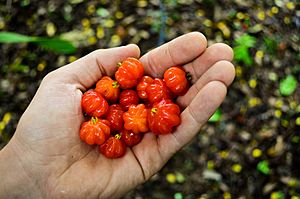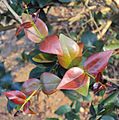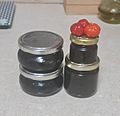Surinam cherry facts for kids
Quick facts for kids Surinam cherry |
|
|---|---|
 |
|
| Conservation status | |
| Scientific classification | |
| Genus: |
Eugenia
|
| Species: |
uniflora
|
| Synonyms | |
|
List
|
|
| Nutritional value per 100 g (3.5 oz) | |
|---|---|
| Energy | 138 kJ (33 kcal) |
|
7.49 g
|
|
|
0.4 g
|
|
|
Protein
|
0.8 g
|
| Vitamins | Quantity
%DV†
|
| Vitamin A equiv. |
9%
75 μg |
| Thiamine (B1) |
3%
0.03 mg |
| Riboflavin (B2) |
3%
0.04 mg |
| Niacin (B3) |
2%
0.3 mg |
| Vitamin C |
32%
26.3 mg |
| Minerals | Quantity
%DV†
|
| Calcium |
1%
9 mg |
| Iron |
2%
0.2 mg |
| Magnesium |
3%
12 mg |
| Phosphorus |
2%
11 mg |
| Potassium |
3%
103 mg |
| Sodium |
0%
3 mg |
|
Link to USDA Database entry
|
|
| †Percentages estimated using US recommendations for adults. | |
The Surinam cherry, also known as pitanga or Brazilian cherry, is a cool flowering plant. Its scientific name is Eugenia uniflora. This plant belongs to the Myrtaceae family, which includes many other fruit trees.
It grows naturally along the east coast of tropical South America. You can find it in countries like Suriname, French Guiana, southern Brazil, Uruguay, Paraguay, and Argentina. People often plant Surinam cherries in gardens to create hedges or screens.
This tree was brought to Bermuda as a decorative plant. However, it has grown so much there that it is now considered an invasive species. This means it can spread quickly and take over areas where native plants used to grow. The tree has also been introduced to Florida.
Contents
Surinam Cherry Plant Description
The Surinam cherry is a large shrub or a small tree. It grows slowly and can reach up to 8 meters (about 26 feet) tall. It often has a cone shape.
Leaves and Branches
The leaves of the Surinam cherry are glossy and oval-shaped. They grow in pairs opposite each other on the branches. When you crush or cut the leaves or branches, they release a strong, spicy smell.
New leaves start with beautiful colors like bronze, copper, or pinkish-red. As they get older, they turn a deep, shiny green. Each leaf can grow up to 4 centimeters (about 1.6 inches) long. In winter, the leaves often change color to red.
Flowers and Fruits
The flowers of the Surinam cherry have four white petals. They grow on long, thin stems. In the middle of each flower, there's a group of white stamens, which are like tiny stalks with yellow tips.
After the flowers bloom, they turn into unique, ribbed fruits. These fruits are usually 2 to 4 centimeters (about 0.8 to 1.6 inches) long. They start green and then change color as they ripen. You'll see them go from orange to bright red, and finally to a dark maroon color.
Birds love to eat these fruits and help spread the seeds. Because of this, the Surinam cherry can sometimes become a weed in tropical and subtropical areas. It might grow in places where it's not wanted, pushing out other plants that naturally belong there.
Uses of Surinam Cherry
The Surinam cherry is useful in many ways, from food to insect control.
Culinary Uses
The fruit of the Surinam cherry is an edible botanical berry. Its taste can be sweet or sour. The flavor depends on the type of plant and how ripe the fruit is. Darker red or black fruits are usually quite sweet. Green or orange fruits tend to be very tart.
People often use the fruit to make jams and jellies. It's also used to add flavor to other foods. The fruit is packed with vitamin C, which is good for your health. It also has provitamin A, which your body turns into vitamin A.
In some parts of Uruguay, people even use the leaves to make tea.
Natural Insect Repellent
In Brazil, people sometimes spread the leaves of the Surinam cherry on their house floors. When the leaves are crushed by walking on them, they release a smell. This smell helps to keep flies away from the house.
Traditional Medical Uses
The Surinam cherry has been used in traditional medicine for a long time. Its essential oil, which is a concentrated liquid from the plant, has some interesting properties. For example, it has been studied for its ability to help with high blood pressure and diabetes. It also shows activity against certain tiny organisms like viruses and fungi.
In South America, people have traditionally used the Surinam cherry as a folk remedy. It is often used to help with stomach problems and to reduce swelling.
Gallery
See also
 In Spanish: Eugenia uniflora para niños
In Spanish: Eugenia uniflora para niños










